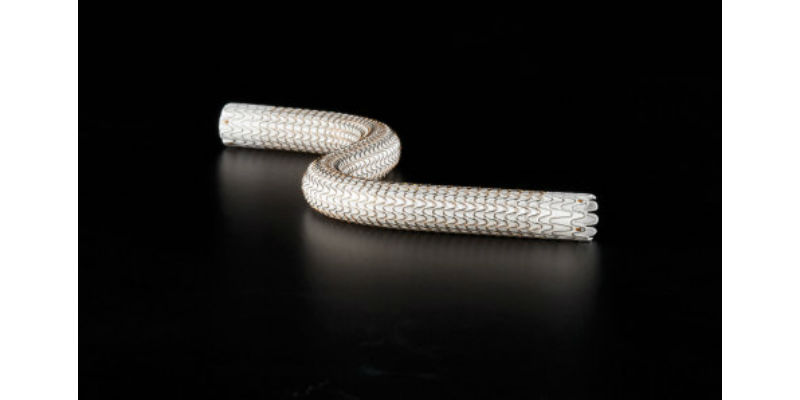W. L. Gore & Associates, Inc. announced the publication of clinical study results in the Journal of Vascular Surgery detailing the success of the GORE VIABAHN Endoprosthesis with heparin bioactive surface in arteriovenous (AV) access graft outflow interventions.
Overall, the device performed significantly better compared to percutaneous transluminal angioplasty (PTA) alone for treatment of challenging AV access cases in a real-world patient population, both in terms of primary patency and in number of interventions over the study period.
Notably, the Gore REVISE Clinical Study was the first AV access stent-graft study to include patients with thrombosed grafts and placement of the device across the elbow joint.

The GORE VIABAHN Endoprosthesis (Credit: Business Wire)
Key findings from the study:
- The device delivered a 47 percent improvement in target lesion primary patency and a 48 percent improvement in circuit primary patency over PTA alone at six months
- The device demonstrated a 50 percent increase over PTA in target lesion primary patency at six months when treating thrombosed AV access circuits
- When placed across the elbow, the VIABAHN endoprosthesis delivered 72 percent target lesion primary patency at six months and 83 percent access secondary patency at 24 months (n=22)
- Median time to target lesion reintervention or graft abandonment with the endoprosthesis was approximately twice that achieved with PTA (203 versus 108 days).
- Placement of VIABAHN led to 27 percent fewer interventions both at the target lesion and in the dialysis access circuit over a 24-month period compared to PTA
According to the United States Renal Data System, there are over 700,000 patients with end-stage renal disease and nearly 90 percent of those patients are receiving hemodialysis. Arteriovenous grafts (AVG) are often used to create dialysis circuits for patients.
Failing dialysis circuits often result in the placement of infection-prone central venous catheters while a new dialysis access circuit is surgically created and matured. Balloon angioplasty is a common fix in the event of a failing circuit, but many patients are unresponsive to the procedure, which has left a gap in treatment capabilities for difficult anatomies.
The clinical study demonstrated that placement of a stent-graft leads to better patient outcomes with reduced interventions, a positive finding for all stakeholders involved in the patient’s care.
In 2013, the Food and Drug Administration granted indication for the GORE VIABAHN Endoprosthesis to maintain and salvage failing dialysis access circuits.
The device is a low profile, flexible, self-expanding, and small-diameter endoprosthesis and the only stent or stent-graft to receive approval for the superficial femoral artery (SFA), in-stent restenosis of bare-metal stents in the SFA, iliac artery, and AV access, according to Gore.
It is constructed with a reinforced, biocompatible, expanded polytetrafluorethylene liner and attached to an external nitinol stent structure. The endoprosthesis also features the company’s CBAS heparin surface, a bonding technology designed to resist thrombus formation.




